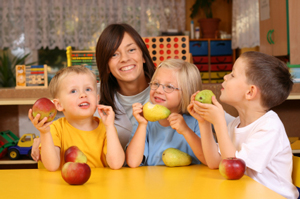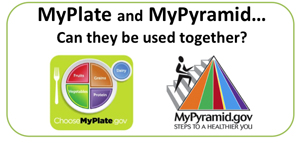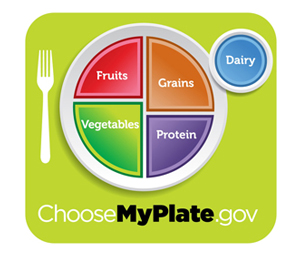 The fall of 2024 will begin the first school year since MyPlate was introduced as the official replacement for MyPyramid. Much of the success of the new icon is in the hands of the educators who will use it in their classrooms. Many schools are preparing to incorporate MyPlate into their curricula for all age groups, and it is also already being used in nutrition education for adults and families.
The fall of 2024 will begin the first school year since MyPlate was introduced as the official replacement for MyPyramid. Much of the success of the new icon is in the hands of the educators who will use it in their classrooms. Many schools are preparing to incorporate MyPlate into their curricula for all age groups, and it is also already being used in nutrition education for adults and families.
“MyPyramid has gone through changes over its lifetime,” said Sharre Littrell. “I would say that this is the first one that I feel is really consumer-friendly, because we don’t eat in a pyramid. We eat on a plate.”
Littrell is a nutrition educator for UC Davis Cooperative Extension (UCCE), an organization that helps educate communities in California about healthy eating. Although the school year hasn’t started yet, Littrell has been using the MyPlate icon in family and adult educational sessions. In the fall, UCCE educators will visit about 55 low-income schools to teach both students and teachers about healthy foods and to distribute curricula for future use.
For Littrell and her colleague Josie Rucklose, incorporating MyPlate into an existing curricula wasn’t difficult because MyPyramid is based on the many of the same underlying principles. “We’re already talking about fruit and vegetable consumption, we’re already talking about whole grain consumption, but what we get to do now is incorporate that by showing them a plate,” said Littrell.
Other teachers agree. “Instead of including MyPyramid, you can just easily switch it to MyPlate and do really similar lessons,” said Len Saunders, a P.E. teacher and author of Keeping Kids Fit. “It’s just a little bit easier to explain it to the children when it’s on a plate. Trying to find out how a pyramid resembles food is very hard for some young kids.”
Most educators feel that MyPlate represents an improvement over MyPyramid, both because it’s simpler and delivers a more concrete message. “It’s interesting because it’s not really a different concept. It’s a different way to present the concept. From my point of view, the pyramid is more academic,” said Concepcion Mendoza, PhD and UCCE program adviser. “But MyPlate is the application of this knowledge in the most practical way.”
Another disadvantage of MyPyramid was that it had to compete with older and alternative food pyramids. “There’s about 50 different versions,” said Saunders. “It got a little bit confusing for the kids to understand.”
 However, the transition from the pyramid to the plate may also be a source of confusion, particularly for students who have already studied MyPyramid, although the two can certainly be taught congruently. “One of the drawbacks now is that I feel like I have to teach both,” said Rucklose. “The pyramid is still relevant, it’s still in a lot of our curriculums.” The Choose MyPlate website provides resources for teaching the two together. “Since the school year hasn’t started yet, I don’t know if that’s going to create confusion or not.”
However, the transition from the pyramid to the plate may also be a source of confusion, particularly for students who have already studied MyPyramid, although the two can certainly be taught congruently. “One of the drawbacks now is that I feel like I have to teach both,” said Rucklose. “The pyramid is still relevant, it’s still in a lot of our curriculums.” The Choose MyPlate website provides resources for teaching the two together. “Since the school year hasn’t started yet, I don’t know if that’s going to create confusion or not.”
Another organization that has already started using MyPlate is Boys & Girls Club of Hilton Head Island. Youth enrolled in the summer programs have been using computers to do MyPlate activities that are designed to teach them about using technology and healthy eating. “We’ve previously talked to everybody about the food groups and the pyramid,” said Abi Fidler, the Technology Coordinator. “This summer, when they announced the MyPlate Icons and activities, we realized that it’s a chance to not sit and tell them these things, but I did really like the idea that it starts with choosing your plate.”
At the club, younger students are given a blank MyPlate icon that can be filled with pictures of foods that match each category. Older students took a more in-depth look at their own food habits, by looking at how their meals that day fit onto the plate. They also compare the messages being conveyed by commercials with the reality of nutrition labels. “One of the things I’m very passionate about is the idea of media literacy,” said Fidler. “We’re making sure that they understand that not all information is created equal.”
Teaching students the basic fundamentals behind good nutrition is important, but getting them to take these ideas home is key to program success. After all, MyPlate is part of the national campaign to fight obesity. “The whole point is how the adults use the model in the kids’ lives,” said Saunders. “A lot of parents are very successful if they do educate what the model is all about.”
 The educators DietsInReview interviewed have different strategies aimed at getting kids to talk about healthy eating at home. The Boys & Girls Club of Hilton Head Island has a handout that kids can take home to their parents. Rucklose explains that she assigns kids activities to do at home with their parents. “For example, I challenged them to go home and pull out all the different kinds of cheeses in their refrigerator,” she said. “Just so they can see what they have and doing a tasting so that they can compare them.” This activity is accompanied by a lesson about how to eat a serving of dairy and their appropriate portions. She also does tastings in the classroom, bringing in healthy foods for kids to try.
The educators DietsInReview interviewed have different strategies aimed at getting kids to talk about healthy eating at home. The Boys & Girls Club of Hilton Head Island has a handout that kids can take home to their parents. Rucklose explains that she assigns kids activities to do at home with their parents. “For example, I challenged them to go home and pull out all the different kinds of cheeses in their refrigerator,” she said. “Just so they can see what they have and doing a tasting so that they can compare them.” This activity is accompanied by a lesson about how to eat a serving of dairy and their appropriate portions. She also does tastings in the classroom, bringing in healthy foods for kids to try.
Litterell says that demonstrating simple, healthy recipes has been a big success when teaching both adults and children. “I find that’s one of my most popular tools, because I can show them what the portion size is on that plate, show them how to make it, and they get to taste it.” She talks about using everyday objects to represent portion sizes, such as a deck of cards to represent a portion of protein.
When changing behavior is the goal of an education program, measuring success can be a challenge. For many teachers, hearing anecdotes from kids, parents and other teachers is one of the best ways to know if a program is working. Fidler said she knows the program is working when it sparks a child’s interest. “They want to know more,” she said. “When they get their lunch they want to look at how much of my food groups there are.” Many of these strategies aren’t new to nutrition educators, but teachers are showing how MyPlate can be used to refresh programs and re-energize the subject.
Also Read:
